
Äthiopischer Opal: Geschichte, Symbolik, Bedeutung und mehr!
 Opale stammen aus aller Welt, doch viele Opalabbaugebiete bringen einzigartige, wunderschöne Opale hervor, die sich von allen anderen unterscheiden. In einem afrikanischen Gebiet findet man beispielsweise die farbenprächtigen äthiopischen Opale, die oft auch Welo-Opale genannt werden.
Opale stammen aus aller Welt, doch viele Opalabbaugebiete bringen einzigartige, wunderschöne Opale hervor, die sich von allen anderen unterscheiden. In einem afrikanischen Gebiet findet man beispielsweise die farbenprächtigen äthiopischen Opale, die oft auch Welo-Opale genannt werden.
Viele Opalliebhaber kennen Australien als die Welthauptstadt der Opale , aber sind äthiopische Opale echt? Absolut!
Während rund 95 % der weltweiten Opale aus australischen Minen stammen, haben moderne äthiopische Opalfunde dieses afrikanische Land hinsichtlich Produktion und Qualität dicht hinter Australien gebracht. Erst kürzlich spielte ein äthiopischer schwarzer Opal eine wichtige Rolle im Film „Uncut Gems“ aus dem Jahr 2019!
Wenn Sie sich noch nicht so gut mit Opalen auskennen, kennen Sie diesen Edelstein vielleicht nur als traditionellen Geburtsstein für Oktober . Vielleicht haben Sie schon vom „ Opalfluch “ gehört oder kennen den Stein einfach wegen seiner kaleidoskopischen Farben – aber es gibt noch so viel mehr zu entdecken, insbesondere über äthiopische Opale.
In diesem Leitfaden entdecken Sie die physikalischen und spirituellen Eigenschaften des äthiopischen Opals sowie die Geschichte und Symbolik dieser phänomenalen Edelsteine!

Was ist äthiopischer Opal?
Der äthiopische Welo-Opal ist eine relativ neue Opalart, die in den Bergregionen Nordäthiopiens, vor allem in der Provinz Wollo, entdeckt wurde.
Was ist der Unterschied zwischen Opal und äthiopischem Opal? Genau genommen keiner, denn äthiopische Opale sind ebenfalls Opale und weisen dieselbe Härte von 5,5 bis 6,5 auf der Mohs-Skala auf. Es gibt jedoch viele verschiedene Opalarten , hauptsächlich Edelopale und gewöhnliche Opale.
Edelopale zeichnen sich durch ihr Farbenspiel aus, während gewöhnliche Opale kein Farbenspiel aufweisen. Äthiopische Opale werden wegen ihres lebhaften Farbenspiels geschätzt, das in zahlreichen Farben und Mustern auftritt.
Ein besonderes Merkmal äthiopischer Opale ist ihre Hydrophanität . Das bedeutet, dass ihre poröse Oberfläche Wasser aufnimmt und dadurch ihr Aussehen, ihre Größe und ihre Stabilität unter Wasser verändert. Diese Steine sind, wie viele Opale, undurchsichtig bis durchscheinend, doch äthiopische Opale werden in Wasser transparent!
Was die Farbe betrifft, so gibt es äthiopische Opale in verschiedenen Varianten, von einfarbigen Tönen wie Schwarz, Rosa oder Blau bis hin zu Regenbogenfarben vor dem Hintergrund verschiedener Körpertöne .
Welche verschiedenen Arten von äthiopischem Opal gibt es?
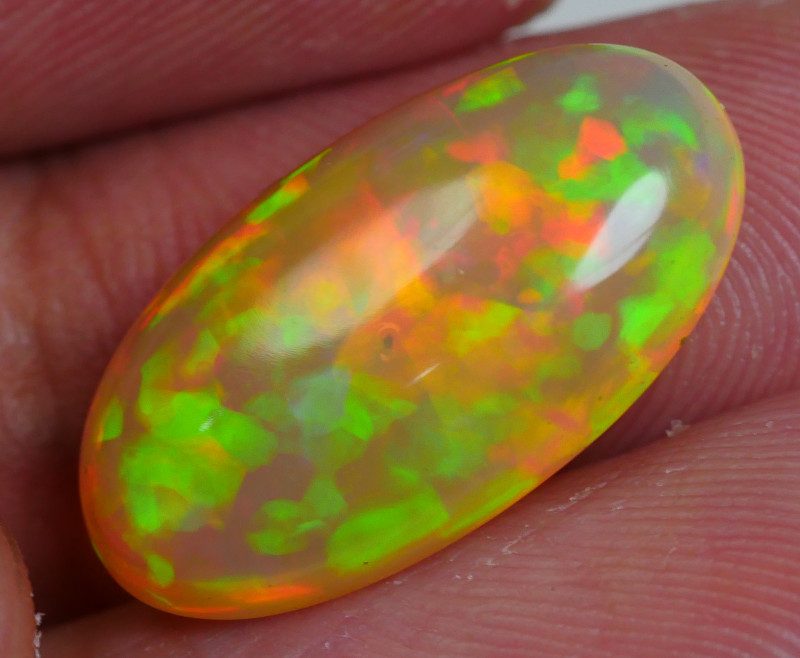
Arten von äthiopischem Opal
Alle äthiopischen Opale weisen ein Farbenspiel auf, unterscheiden sich jedoch in ihrer Grundfarbe. Die drei wichtigsten Lagerstätten (auf die wir später noch genauer eingehen werden) bringen unterschiedliche Varietäten hervor, darunter:
Edles Feueropal: Reichlich vorkommende, durchscheinende Opale aus der Wollo-Provinz mit der roten, orangen oder gelben Körperfarbe von Feueropalen und dem für Edelopal typischen Farbenspiel, das oft lebhafte violette und grüne Farbblitze zeigt.
Schwarzer Opal: Seltene, natürlich schwarze Opale , die nicht hydrophan sind und in der Stayish-Mine in der Provinz Wollo gefunden werden, obwohl viele äthiopische Opale behandelt werden, um schwarz zu sein.
Shewa- oder Mezezo-Opal: Die ersten äthiopischen Exemplare wurden 1994 in der Provinz Shewa entdeckt. Sie sind typischerweise rotbraun, orange oder schokoladenbraun, weisen aber oft Probleme mit Craquelé auf – einer Art von Beschädigung, bei der die Trocknung zu netzartigen Rissen führt.
Weißer Edelsteinopal: Äthiopische Opale mit weißer Grundfarbe, leuchtendem Farbenspiel und deutlich besserer Farbstabilität als Shewa-Opale. Sie werden typischerweise in der Nähe von Wegel Tena gefunden.
Diese Beispiele decken nicht alle Arten äthiopischer Opale ab, da die Anzahl der Körperfarben und Muster derjenigen australischer Opale in nichts nachsteht. Apropos, worin unterscheiden sich australische und äthiopische Opale?
Der Hauptunterschied zwischen australischen und äthiopischen Opalen besteht darin, dass äthiopische Opale in der Regel größer, seltener und günstiger sind als australische Opale.
Ein wesentlicher Unterschied zwischen australischen und äthiopischen Opalen liegt in ihren Entstehungsprozessen, die wir im Folgenden besprechen werden!
Eigenschaften des äthiopischen Opals
Im Gegensatz zu australischem Opal, der tief unter der Erde entsteht, bildet sich äthiopischer Opal hoch oben in den Bergen. Vulkanische Aktivität ist für die Entstehung dieser Hydrophanopale verantwortlich, und sie treten eher knollenförmig (wie klumpenartige Kugeln) als fugenförmig wie die meisten Opale auf.
Nach dem Abbau werden die Opale geschliffen und bewertet – doch wie erfolgt die Graduierung? Da der Stein in der Branche noch relativ neu ist, ist die Graduierung äthiopischer Opale komplex und bisweilen subjektiv, aber im Allgemeinen werden sie nach Muster, Helligkeit, Behandlungen und Farbe bewertet.
Muster
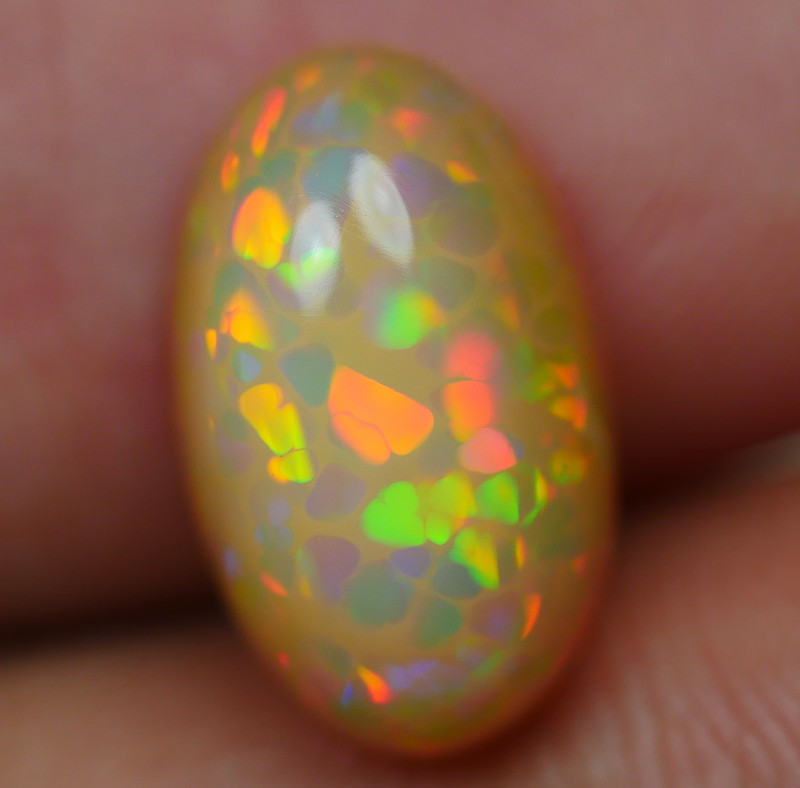
Äthiopische Opale sind einzigartig in ihren vielfältigen und lebendigen Mustern, die von Welo Broad Flash bis hin zu Fire Cloud reichen! Das begehrteste Muster ist die Wabenstruktur, die ausschließlich bei äthiopischen Opalen vorkommt. Dabei bildet gewöhnlicher Opal eine Linie mit netzartigen Einschlüssen, die sich über den gesamten Stein erstrecken. Steine mit Wabenmuster werden typischerweise als Cabochons geschliffen.
Helligkeit
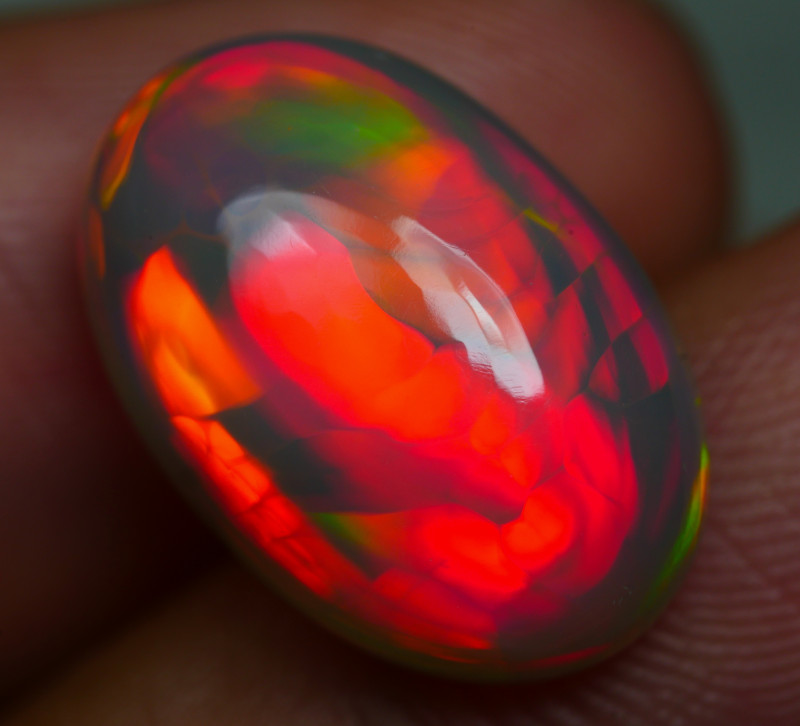
Die Leuchtkraft eines Steins beschreibt sein „Feuer“ oder die farbigen Lichtreflexe, die durch die Lichtbrechung entstehen. Das Feuer vieler äthiopischer Opale zeigt einen seltenen dreidimensionalen Effekt. Typischerweise leuchten blaue und grüne Farben, selten kommt jedoch auch ein roter Schimmer vor. Generell erzielen Steine mit einem helleren, intensiveren Feuer höhere Preise.
Behandlungen
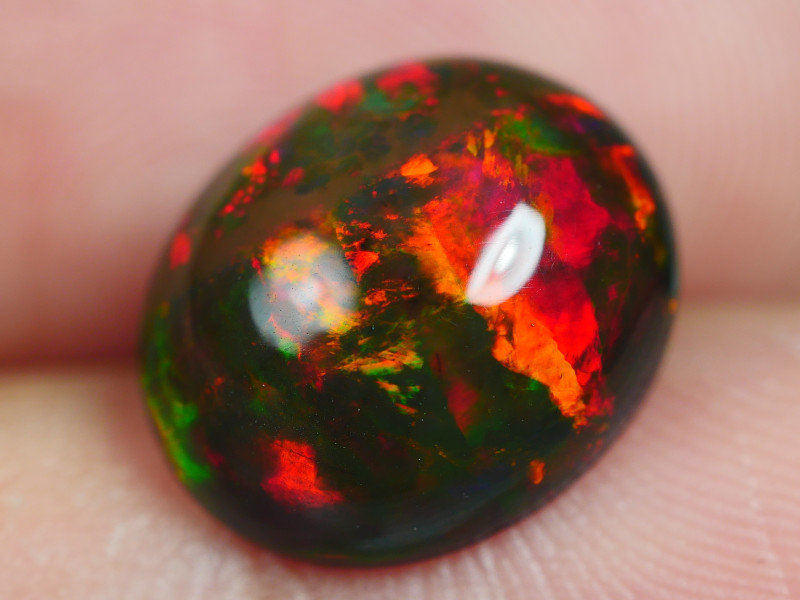
Eine beträchtliche Anzahl äthiopischer Opale wurde behandelt. Neben grundlegenden Füllbehandlungen zur Reduzierung von Haarrissen sind die drei wichtigsten Techniken die Zucker-Säure-Behandlung, das Räuchern und das Färben.
Bei der Zucker-Säure-Behandlung wird der Opal zunächst in Zuckerwasser und anschließend in Schwefelsäure eingeweicht. Dadurch entstehen auf der Oberfläche Flecken und Verfärbungen, die den Grundton verdunkeln und so das Farbenspiel intensivieren.
Die Rauchbehandlung erzielt ähnliche Ergebnisse. Dabei wird der Opal in Papier eingewickelt, in einem geschlossenen Behälter erhitzt, anschließend abgekühlt und gewaschen. Hydrophane Opale vertragen die Rauchbehandlung gut, allerdings wird sie dadurch schwerer zu erkennen.
Die hydrophane Natur äthiopischer Opale eignet sich auch gut zum Färben, was man häufig bei leuchtend violetten oder rosa äthiopischen Opalen sieht, da diese Farben nicht natürlich vorkommen.
Farbe

Äthiopische Opale können je nach Mine weiß, schwarz, blau, rot, rosa, orange oder braun sein. Farblose Kristallopale stammen aus der Wegel-Tena-Mine.
Die Körperfarbe ist für den Wert äthiopischer Opale nicht so entscheidend wie beispielsweise bei schwarzen Opalen. Ihre Hauptbedeutung liegt in ihrem Einfluss auf die Leuchtkraft und die Muster des Steins.
Welche Farbe äthiopische Opale haben, hängt unter anderem von der Provinz ab, aus der sie stammen – ein grundlegender Aspekt ihrer Geschichte!
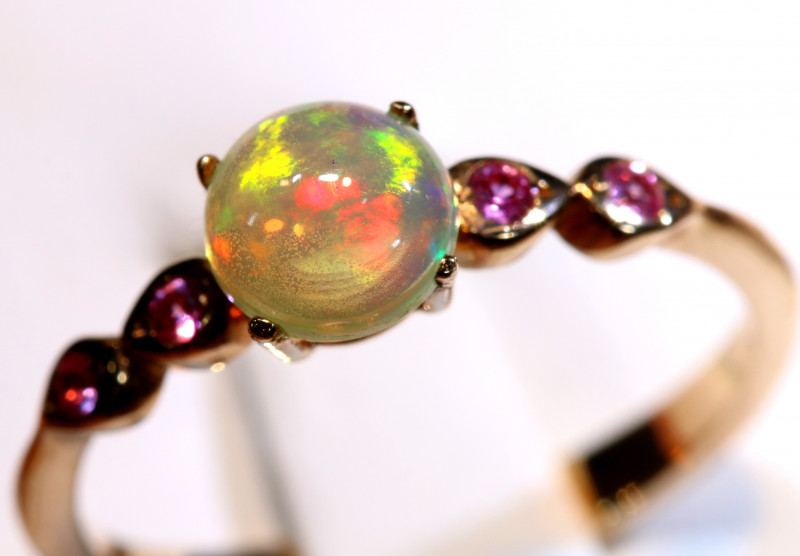
Geschichte des äthiopischen Opals
Die moderne Entdeckung äthiopischer Opale erfolgte erst in den letzten Jahrzehnten. Die ältesten Opale, die in einer kenianischen Höhle gefunden wurden und auf etwa 4000 v. Chr. datiert werden, waren jedoch höchstwahrscheinlich äthiopische Opale! Anthropologen vermuten, dass die frühesten Vorfahren des Menschen diese Opale zur Werkzeugherstellung nutzten.
Unsere prähistorischen Vorfahren nannten sie allerdings nicht „Opale“. Der Name „Opal“ stammt vom altindischen Wort Upala , was „Edelstein“ bedeutet, und dem späteren griechischen Opallios, was so viel wie „einen Farbwechsel sehen“ bedeutet.
Im Jahr 1994 entdeckten Bergleute in der Provinz Shewa das erste äthiopische Opalvorkommen. Die kostbaren Opale befanden sich in vulkanischen Gesteinsknollen und wiesen eine braune, rötlich-braune oder orange Färbung auf. Leider neigten sie auch zu Haarrissen.
Im Jahr 2008 entdeckten Bergleute in der Wollo-Provinz nahe Wegel Tena ein zweites Opalvorkommen. Die Opale von Wegel Tena waren haltbarer als die von Shewa und wiesen attraktivere Farbvarianten wie weiße, Kristall-, Feuer- und gelegentlich auch schwarze Opale auf. „Welo-Opal“ wurde bald zum Handelsnamen für die Opale dieses Vorkommens.
Interessanterweise weisen die weißen Opale von Wegel Tena einen hohen Bariumgehalt auf, mitunter auch Einschlüsse von Pyrit und Kohlenstoff. Einige Exemplare zeigen zudem „fingerartige“ Muster, bei denen Schichten aus gewöhnlichem und kostbarem Opal das Farbenspiel in fingerähnlichen Säulen erzeugen.
Die letzte bedeutende Entdeckung im Jahr 2013 erfolgte in der Stayish-Mine, ebenfalls in der Wollo-Provinz. Einige der gefundenen Exemplare waren weiß oder kristallin, die Mehrheit jedoch schwarz oder dunkelgrau.
Heute ist die Lagerstätte Wegel Tena für ihren atemberaubenden weißen und kristallinen Opal bekannt, während die Mine Stayish für ihren schwarzen Opal berühmt ist.
Das Farbenspiel äthiopischer Opale ist im Allgemeinen intensiver als das australischer Opale, und die horizontalen Stollen erleichtern den Abbau im Vergleich zu vertikalen Schächten. Äthiopische Bergleute haben bereits über 1.500 kg rohen äthiopischen Opal gefördert!
Abgesehen von der Geologie, welche spirituelle Bedeutung hat Opal?
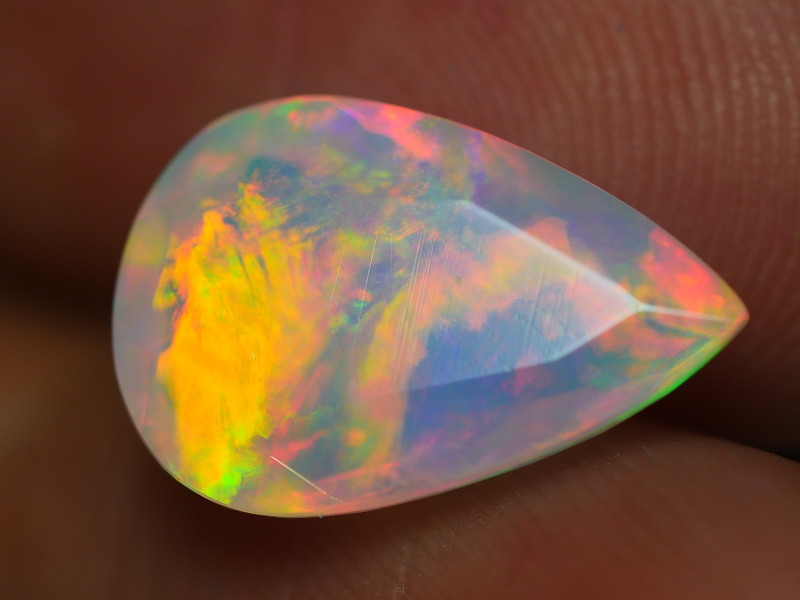
Äthiopischer Opal: Bedeutung und Symbolik
Wie andere Opal-Edelsteine symbolisiert auch der äthiopische Opal Hoffnung, Glück und Unschuld. Darüber hinaus stehen diese Steine für Begeisterung und Kreativität.
Was ist die Bedeutung des äthiopischen Feueropals?
Feueropale symbolisieren Leidenschaft, Wärme und Liebe. Sie stehen für tiefe emotionale Heilung und das Vertrauen, dass alles im Leben einen Sinn hat. Als Geschenk sind diese Steine ein Symbol für Treue und Freundschaft.
Diese Schätze stammen aus Äthiopien und blicken bereits auf eine reiche Kulturgeschichte zurück. Äthiopien, das „Land der Ursprünge“, ist die Heimat der ersten Menschen, des ersten Kaffees und das einzige afrikanische Land mit einem eigenen Schriftsystem.
Auch andere Kulturen haben dem äthiopischen Opal ihre eigene spirituelle Bedeutung beigemessen. Die arabische Folklore erzählt von Opalen, die durch Blitze vom Himmel fallen, während die Azteken Opale zum Schutz vor Flüchen wie dem bösen Blick verwendeten.
Welchen mystischen Eigenschaften werden Opalen heute zugeschrieben?
Wozu sind äthiopische Opale gut?
Die physikalischen Eigenschaften des äthiopischen Opals weisen Parallelen zu vielen seiner heilenden Eigenschaften auf, insbesondere in seiner Hydrophanzusammensetzung und seinen Farbblitzen.
Da diese Hydrophanopale Wasser absorbieren, können sie bei Dehydrierung, Wassereinlagerungen und Müdigkeit helfen. Angeblich sollen diese Steine auch die Gesundheit von Augen, Haaren und Haut verbessern!
Äthiopischer Opal wirkt emotional wohltuend auf alle, die mit Unentschlossenheit, Kommunikationsschwierigkeiten oder Pessimismus zu kämpfen haben. Die leuchtenden Farben des Steins erinnern daran, die eigenen Stärken zu nutzen, Negativität loszulassen und kreativen Bestrebungen nachzugehen.
Die spirituelle Seite des äthiopischen Opals ist erhellend und besitzt reinigende Eigenschaften, die zu mehr Zufriedenheit beitragen können. Eine Affirmation mit äthiopischem Opal zur Meditation lautet: „Ich bin von der Vergangenheit gereinigt und bereit für die Zukunft.“
Äthiopisches Opal-Chakra
Bei der Chakra-Heilung wird äthiopischer Opal mit dem Kronenchakra in Verbindung gebracht. Dieses Chakra befindet sich oberhalb des Kopfes und steht für Selbstverwirklichung und Spiritualität.
Wenn das Kronenchakra blockiert ist, kann man sich instabil fühlen oder dem persönlichen Wachstum widerstehen. Äthiopischer Opal kann das Chakra öffnen und so Weisheit und eine spirituelle Verbindung zum Universum ermöglichen.
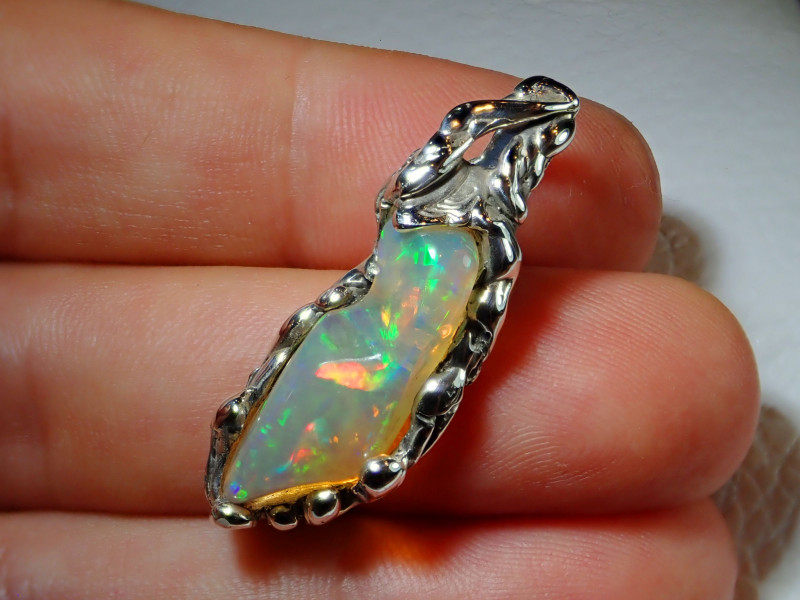
Verzaubert von äthiopischem Opal?
Ob Sie schwarzen, weißen oder Feueropal bevorzugen – bei äthiopischen Opalen finden Sie alles, was das Herz begehrt. Dank ihrer reichen Geschichte und ihrer heilenden Eigenschaften ist ein Ring aus äthiopischem Opal die perfekte Wahl, um Ihren Geburtstag im Oktober zu feiern oder einfach Ihren einzigartigen Stil zu unterstreichen!
Suche nach Opal Encyclopedia
Verwandte Auktionen
In Verbindung stehende Artikel
Die NASA entdeckte zunächst Opal auf dem Mars und hat nun bestätigt, dass es dort fließendes Wasser gibt. Erfahren Sie, wie die beiden Entdeckungen zusammenhängen.
22nd Jun 2017
Haben Sie sich jemals gefragt, welche Tiere des australischen Outbacks in den Opalfeldern vorkommen? Begleiten Sie uns auf unserer Entdeckungsreise in die aufregende Welt des Outbacks!
22nd Jul 2020
Was bedeutet „Down Under“? Erfahren Sie mehr über die Geschichte des Ausdrucks, seine Bedeutung und wie er zu einer Bezeichnung für das Land und den Kontinent Australien wurde.
7th Sep 2020
Neue Artikel
Schwarze Opale sind die begehrteste Opalart. Ihre tiefe Basis erzeugt ein regenbogenfarbenes Farbenspiel an der Oberfläche. Entdecken Sie die Verwendung, Eigenschaften, Geschichte und den Wert schwarzer Opale!
7th Dec 2025
Erfahren Sie, wie Opale bewertet werden und welche Faktoren ihren Preis beeinflussen. Von Farbe und Leuchtkraft bis hin zu Schliff und Herkunft – lernen Sie, wie die verschiedenen Opalarten bewertet werden, inklusive Preisbeispielen.
19th Jul 2023
Begeben Sie sich auf eine Reise und erfahren Sie von unserer Gastautorin Vivien Schapera von Crystal Healing Techniques mehr über die Heilkraft von Opalen!
20th May 2023
Artikelkategorien
All there is to know about Opals including Black Opals, Ethiopian Opals & Boulder Opal
14 Artikel
Check out our fascinating information and articles on all things amazing in the Opal world
41 Artikel
Opal Auctions sellers who are approved as opal Verified Sellers
4 Artikel





